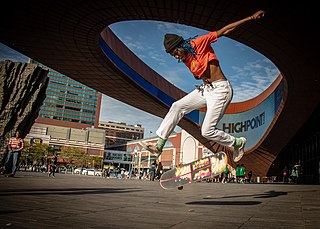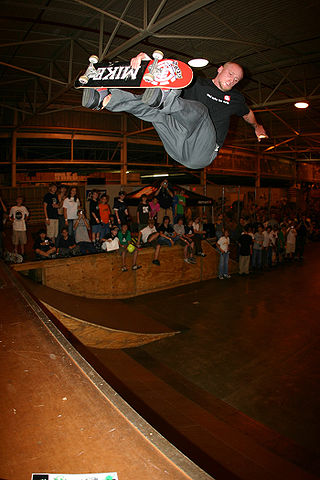This article needs additional citations for verification .(July 2023) |
Lip tricks in skateboarding are performed on half-pipes, quarterpipes and mini ramps. They are tricks that require different varieties of balance on the "lip" of the ramp. The first lip trick done was by Jay Adams.
| Axle stall | An axle stall is a stall on both trucks of a skateboard. It is used commonly to regain composure before performing another trick or to "drop in" on a ramp. Essentially a stationary 50-50. Can be done frontside or backside. | |
| Bastard Plant | Backside Boneless One to Fakie. Popularized by Sean Goff | |
| Bean Plant | A nosegrab or melon grab (a.k.a. lien grab—hence the name) wherein the front foot is planted from the heel edge of the board. Though originally performed frontside it is most commonly done to fakie. Invented by Neil Blender. ("Lien" is "Neil" spelled backward.) | |
| Half Shave Plant | A no comply slob grab. Invented by Gage Flynn. | |
| Blunt to Fakie | The back truck is placed over the lip of the ramp and the tail is placed on the lip, appearing like a stationary blunt stall, hence the name. A small ollie is then performed to come off the lip and ride back down the ramp in fakie. You can also do a small 180 ollie out, if you ollie out frontside you get a frontside blunt stall, and likewise for a backside 180. Originally, this trick was pulled back in with a variety of grabs and invented by Kevin Staab. The "ollie blunt" as it was originally called was invented by Seattle's Aaron Dieter. | |
| Boneless One | Originally, a frontside footplant in which the grab is standard frontside, preferably tuck-knee, remove your front foot from the heel-side rail, boost, place it back on the board and release well before the board re-enters. The backside variant, invented by Steve Caballero, is a standard backside grab with the front foot coming off the toe-side rail. Boosting (ideally), place your foot back on and release your grab before the board re-enters. The frontside version was invented by Garry Scott Davis on banks and was named after a friend's puppet called Harry the Boneless One. The trick was later taken to vert by Steve Caballero. | |
| Crailtap | A crailtap is a tailtap but done while holding the board's nose with the trailing hand (crail grab) and pivoting the board on the tip of its tail. | |
| Dark stall | Stalling on a coping or edge while having the board be upside down so the grip side is touching the ground. Invented by Rodney Mullen. | |
| Disaster | Invented by the "Master of Disaster" Duane Peters, this trick is where the skater ollies 180 degrees and lands in the center of his board with the front trucks facing towards the ramp and the back trucks over the lip. The skater then leans forwards to return in the ramp. | |
| Fakie | Any trick that goes back in switchstance which was not initiated from a "switched" stance, or when the normal back foot is the leading foot. | |
| Sausage Grind | A frontside Smith grind/tail grab. Very aggro. Invented by Steve Claar, I believe. | |
| Footplant/Fastplant | A backside air grabbing melon with the back foot coming off and planting on the coping, stalling, and coming back in regular, invented by Eric Grisham. A Fastplant is a high-speed backside foot-plant, boosting, and put back on the tail well before the board re-enters the ramp/pool/bank. Invented by Neil Blender. F/S Footplant is a frontside air with your back foot planting on the coping. Basically, an Indyplant going frontside. | |
| Feeble | Much like the 50-50 however the front truck extends over the coping or top of the ramp, lapped over the "wrong way," so to speak. | |
| Hurricane | A backside carving approach at the lip or curb into an alley-oop frontside fakie grind, often with the heel-side rail sliding along with the back truck grinding—the front truck is in a feeble orientation. Originally, the hurricane was done to a fast 270 back-truck pivot to forward re-entry, but they can also be done to fakie. Invented by Tom Groholski and Dan Wilkes. In Dallas, Texas on The Blue Ramp at Bachman Lake. | |
| I Can Hear Fine | Backside Boneless grabbing Mute. | |
| Indy Plant | Backside footplant with the back foot planting and grabbing Indy. Popularized by Tom Groholski | |
| Lien Plant | A Frontside Fastplant grabbing lien (front heel side edge). Popularized by Mark Rogowski and Neil Blender. | |
| New Deal | Invented by Neil Blender. Essentially a nosepick snapped off into a disaster. Can also be done while grinding, then sliding. | |
| Nose blunt | Either 180 up to the lip, or come up fakie and land on the front foot with your nose and truck balancing on the edge of the coping. A nollie or grab is then done to come back into the ramp. tailgrab and frontside grab is recommended. | |
| Nose pick | A stall on the front truck which is grabbed for re entry. May be done B/S or F/S. | |
| Nose stall | A trick where the skater reaches the top of the transition, leans on the skateboard's nose atop the ramp, and drops back in switch or reverts to regular either frontside or backside. | |
| Pivot | the most basic go up and turn around on your back truck. Add a little flair by slashing at the coping instead. frontside or backside. | |
| Pogo | Any air straight up and then landing in a rock and roll. Popularized by Craig Johnson, who would do them 5 feet or higher. Also see "Sally Rock." | |
| Revert | Performing a Pivot immediately after an air. | |
| Rock and Roll | Similar to the Rock to Fakie only a quick 180 is done as you come off the lip so that you don't ride fakie. The frontside variation, originated by Eddie Elguera, is much harder and is considered one of the most stylish lip tricks. | |
| Rock to Fakie/Fakie Rock | This is a quick, common and easy lip trick performed mostly to link tricks together on mini ramps. The front truck is placed over the lip of the ramp and then the board is "rocked" slightly before coming back down backwards (fakie). | |
| Sally Rock | Ollie air straight up and then landing in a rock and roll to fakie. Proper execution is done fluid and fast. Sometimes referred to as a "Pop Rock." Invented by Salman Agah. | |
| Slob Plant | Frontside Fastplant grabbing slob. | |
| Smith Grind | A trick where the back trucks are on the coping and the front trucks aimed into the ramp. Can be done as a stall or grinded. The frontside version was invented by Mike Smith, [1] [2] [3] while the backside version was invented by Monty Nolder. | |
| Staple Gun | A rider rides straight up and off the ramp while placing the back foot on the transition below the coping. The board is then stomped down onto the platform with the front foot and pulled back into the ramp toward the back ankle. Hopping of the back foot and back onto the board, the rider rides away fakie. | |
| Sugar Cane | Like the hurricane except you Ollie 270 into a smith grind. | |
| Sweeper | Similar to a lein-to-tail. A fronstide nose grab foot plant, where the back foot is taken off and rests on the coping. Variation: Creeper - a crail grab sweeper. Invented by Duane Peters. | |
| Switch | (not really a trick but a fundamental again.) Any goofy foot trick executed by a regular foot skater or vice versa. Get it? You switch your stance. There is no such thing as switch fakie. (or frontside indy for that matter) Fakie is when you roll backwards with your tail in front, period. If you're going fakie but your nose is in front then you are actually switchstance because the board rides and feels different. | |
| Tailtap/Tailblock | backside/stand-up pivot stall, balancing on the bottom tip of the tail while grabbing the nose with your front hand. Can be done with the back hand also (crailtap/crailblock) Again, stall it out. Then guide your board back in with your hand. Very late 70's early 80's. | |
| Texas Plant | Go up to the lip frontside and take the back foot off and plant it on the coping, while grabbing the tail and extending the front leg. Traditionally there is a slight pause before the skater jumps back while simultaneously returning the rear foot to its proper location. It was invented by Texas skate master Craig Johnson. | |
| Texas Two-Step | Identical to a Texas Plant, except that, like in a Switch-Foot Pogo, the rider constantly (until dropping back in) alternates the planted foot. | |
| Thruster | A fakie tail grab foot plant, where the back foot boosts off the coping. Can be done straight up and down, or moving across the coping. Invented by Duane Peters, popularized by Craig Johnson. |












